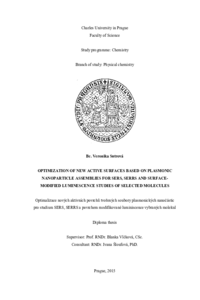Optimization of new active surfaces based on plasmonic nanoparticle assemblies for SERS, SERRS and surface-modified luminescence studies of selected molecules
Optimalizace nových aktivních povrchů tvořených soubory plasmonických nanočástic pro studium SERS, SERRS a povrchem modifikované luminiscence vybraných molekul
rigorózní práce (UZNÁNO)

Zobrazit/
Trvalý odkaz
http://hdl.handle.net/20.500.11956/87660Identifikátory
SIS: 192776
Kolekce
- Kvalifikační práce [19113]
Autor
Fakulta / součást
Přírodovědecká fakulta
Obor
Fyzikální chemie
Katedra / ústav / klinika
Katedra fyzikální a makromol. chemie
Datum obhajoby
4. 8. 2017
Nakladatel
Univerzita Karlova, Přírodovědecká fakultaJazyk
Angličtina
Známka
Uznáno
Klíčová slova (česky)
plasmonické nanočástice, SERS, SERRS, povrchem-modifikovaná luminiscenceKlíčová slova (anglicky)
plasmonic nanoparticles, SERS, SERRS, surface-modified luminescenceByly připraveny dva typy 3-dimenzionálních (3D) Ag agregátů s vnitřní nanohoubovitou strukturou a testovány jako vzorky pro povrchem zesílený Ramanův rozptyl (SERS) a jako aktivní povrchy pro povrchem zesílenou luminiscencí. 3D Ag agregát s vnitřní nanohoubovitou strukturou byl připraven z fraktálních 2D fúzovaných agregátů (D = 1,87 ± 0,02) získaných modifikací hydrosolu Ag nanočástic (NČ) připraveného redukcí AgNO3 pomocí NH2OH∙HCl. Pro SERS měření byl připraven Ag agregát se začleněnými kationty [Ru(bpy)3]2+ a Cl- anionty, který byl převrstven tenkou vrstvou vodné fáze. Modifikací Ag NČ chloridy vznikly fraktální fúzované agregáty, ze kterých byl následně připraven 3D Ag agregát pro měření povrchem zesílené luminiscence. Po přípravě byl agregát převrstven 1×10-5 M vodným roztokem [Ru(bpy)3]2+ . SERRS (1×10-14 M) a SERS (1×10-15 M) limity detekce [Ru(bpy)3]2+ určené při excitační vlnové délce 445 a 532 nm odpovídají mezi detekce na úrovni detekce jedné molekuly. K možnosti detekce na úrovni jedné molekuly přispívá zesílení elektromagnetickým mechanismem v důsledku lokalizace [Ru(bpy)3]2+ do "hot spots", efektivní lokalizace "hot spots" do fokusu laserového svazku při mikro-Ramanském spektrálním měření a příspěvek molekulární rezonance k celkovém zesílení signálu. Fosforescenční měření z 3D Ag...
Two types of 3-dimensional (3D) Ag nanosponge aggregates were prepared and tested as samples for surface-enhanced Raman scattering (SERS) and as active surfaces for surface-enhanced luminescence. 3D Ag nanosponge aggregates were assembled from 2D fused fractal aggregates (D = 1.87 ± 0.02) prepared by modification of Ag nanoparticle (NP) hydrosol resulting from the reduction of AgNO3 by NH2OH∙HCl. For SERS measurements, 3D Ag nanosponge aggregates with incorporated [Ru(bpy)3]2+ cations and chloride anions were prepared and overlayed by a thin layer of aqueous phase. For SEL measurements, the 3D Ag nanosponge aggregates were assembled from fused fractal aggregates of chloride-modified Ag NPs. After preparation the active surface was overlayed by a 1×10-5 M aqueous solution of [Ru(bpy)3]2+ . The SERRS (1×10-15 M) and SER(R)S (1×10-14 M) limits of detection of [Ru(bpy)3]2+ determined at 445 and 532 nm excitations, respectively, correspond to the single molecule level of the complex detection. Its achievement is attributed to a large electromagnetic mechanism enhancement experienced by [Ru(bpy)3]2+ incorporated in "hot spots", an efficient localization of "hot spots" in the 3D aggregate to the focus of the laser beam in micro-Raman spectral measurements and to a molecular resonance contribution to the...
